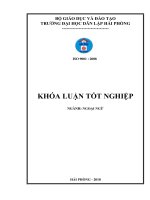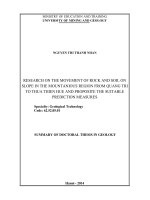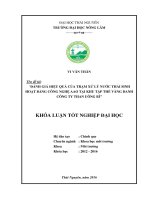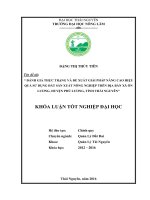Research on the process of separating collagen from horse skin (khóa luận tốt nghiệp)
Bạn đang xem bản rút gọn của tài liệu. Xem và tải ngay bản đầy đủ của tài liệu tại đây (2.43 MB, 59 trang )
VIETNAM NATIONAL UNIVERSITY OF AGRICULTURE
FACULTY OF BIOTECHNOLOGY
-------------***-------------
GRADUATION THESIS
TITLE: RESEARCH ON THE PROCESS OF
SEPARATING COLLAGEN FROM HORSE SKIN
HANOI – 2022
VIETNAM NATIONAL UNIVERSITY OF AGRICULTURE
FACULTY OF BIOTECHNOLOGY
-------------***-------------
GRADUATION THESIS
TITLE: RESEARCH ON THE PROCESS OF
SEPARATING COLLAGEN FROM HORSE SKIN
Student name
: VU THI YEN
Student code
: 637193
Class
: K63CNSHE
Faculty
: BIOTECHNOLOGY
Supervisor
: Dr. LE THI BICH THAO
: Dr. NGUYEN THANH HAO
HANOI – 2022
DECLARATION OF AUTHORSHIP
I hereby declare that this is my research work under the guidance of Dr. Le
Thi Bich Thao and the co-direction of Dr. Nguyen Thanh Hao.
The data and results presented in the thesis are honest and partly published
in the proceedings of the Vietnam National Conference on Biotechnology 2022
with the consent and permission of the co-authors.
The rest has not been published by anyone in any other work.
Hanoi, day 22 month 2 year 2023
Student
Vu Thi Yen
i
ACKNOWLEDGEMENTS
I would like to express my sincere gratitude and boundless gratitude to Dr.
Le Thi Bich Thao, Head of the Protein Biochemistry Department, Institute of
Biotechnology, as well as the main instructor in my research. Dr. Le Thi Bich
Thao not only enthusiastically guided and taught me, but also created conditions
to support and encourage me during the past time so that I could complete my
thesis. In particular, she also instilled in me a passion for scientific research and
helped me have a clear direction for my future research. I have also learned a lot
from Dr. Le Thi Bich Thao's valuable experiences in recent years. Again, I
sincerely thank you.
I would also like to express my deep gratitude to Dr. Nguyen Thanh Hao
(Lecturer of biology, Vietnam National University of Agriculture), who was my
co-guide in my research. In addition to talking with me about experimental results,
the doctoral scholar also encouraged me and shared with me the difficulties of
scientific research, and I am very grateful for that help.
I am extremely grateful and dear to my parents, who gave birth to me and
raised me up. My parents have always been a source of encouragement and
comfort for me throughout my life, and I would like to share this joy with them
as a gift to affirm my growth and maturity.
I would like to thank my sister and two cousins, who always bring me joy,
help, and sincere encouragement.
I am also very grateful to the aunts and uncles, brothers and sisters, and
colleagues at the Department of Protein Biochemistry, Institute of Biotechnology.
Ms. Bui Thi Huyen and Ms. Pham Thi Hue taught me many practical things, and
I learned a lot from the experience when we worked together. Colleagues Ngo
Nhat Quang, Nguyen Thuy Dung have shared with me in scientific research and
in life. You always bring me joy, laughter, and comfort so that I can work in a
ii
friendly and united scientific environment. I always look forward to working with
all my uncles and colleagues forever.
Finally, I would like to thank the Board of Directors of the institute of
Biotechnology, the Leadership of the Key Laboratory of Gene Technology, the
aunts and uncles, brothers and sisters, and colleagues working at the Institute of
Biotechnology. They collaborated in research as well as created favorable
conditions for me to complete the thesis
Hanoi, day 22 month 2 year 2023
Student
Vu Thi Yen
iii
CONTENTS
DECLARATION OF AUTHORSHIP ................................................................... i
ACKNOWLEDGEMENTS .................................................................................. ii
CONTENTS ......................................................................................................... iv
ABBREVIATIONS .............................................................................................. vi
LIST OF TABLES ............................................................................................. viii
LIST OF FIGURES .............................................................................................. ix
PREAMBLE.......................................................................................................... 1
PART I: INTRODUCTION ............................................................................... 3
1.1. What is collagen? ........................................................................................... 3
1.2. How many types of collagen are there? ......................................................... 4
1.3. Structures of collagen ..................................................................................... 6
1.4. Application and origin of collagen types ....................................................... 7
1.4.1. Applications in food technology ................................................................. 7
1.4.2. Applications in medicine and pharmaceuticals........................................... 9
1.4.3. Applications in the cosmetic industry ....................................................... 11
1.5. Research situation on collagen extraction in the country and in the world . 13
PART II. MATERIALS AND METHODS OF RESEARCH ...................... 18
2.1. Materials ....................................................................................................... 18
2.2. Chemicals, machinery and equipment ......................................................... 18
2.3. Methods of research ..................................................................................... 19
2.3.1. Sample treatment ....................................................................................... 21
2.3.2. Collagen extraction ................................................................................... 22
2.3.3. Preservation of hydrolyzed collagen ......................................................... 26
2.3.4. Quantitative technique of collagen concentration dissolved in extract
solution ................................................................................................................ 27
2.3.5. Data processing ......................................................................................... 29
iv
PART III. RESULTS AND DISCUSSION ..................................................... 30
3.1. Effect of enzymes on the concentration of soluble collagen in pepsin ........ 32
3.2. Effect of ultrasonic on the concentration of soluble collagen in pepsin ...... 36
3.3. Effect of temperature on the concentration of soluble collagen in pepsin... 38
3.4. Determination of the efficiency of collagen extraction ............................... 39
3.5. Surface morphology of PSC from horse skin .............................................. 42
CONCLUSIONS................................................................................................ 43
REFERENCE ...................................................................................................... 44
v
ABBREVIATIONS
Abbreviations
AEE
Associated equine encephalitis
BSE
Bovine spongiform encephalopathy
DNA
Deoxyribonucleic acid
FMD
Foot and mouth disease
FE-SEM
Field Emision Scanning Electron Microscopy
SEM
Scanning Electron Microscopy
HCl
Hydrogen Chloride
(24)h
(24) hours
kDa
Kilo Dalton
kHz
Kilohertz
kV
Kilovolt
M
Molarity
Min
Minute
nm
Nanometer
NaCl
Sodium Chloride
NaOH
Sodium Hydroxide
Pa
Pascal
pH
Potential of hydrogen
PSC
Pepsin-soluble collagen
Pt
Platium
rpm
Revolutions per minute
SDS-PAGE
Sodium Dodecyl Sulphate-Polyacrylamide Gel
Electrophoresis
SDS
Sodium Dodecyl Sulphate-Polyacrylamide
vi
UV-Vis
Ultraviolet and visible
U/g
Unit/gram
W
Watt
w/w
Weight/weight
w/v
Weight/volume
α1
Alpha 1
α2
Alpha 2
β
Beta
o
Celsius
µl
Microliter
C
vii
LIST OF TABLES
Table 1.1. Collagen classification table (Pope et al., 1983) .................................. 4
Table 2.1. Chemicals ........................................................................................... 18
Table 2.2. Machinery and equipment .................................................................. 19
Table 3.1. Results of collagen mass obtained when extracted at room temperature
(25-26oC) using 2% pepsin ratio (w/w) with ultrasonic ..................................... 39
Table 3.2. Results of collagen mass obtained when extracted at room temperature
(25-26oC) using 1% pepsin ratio (w/w) .............................................................. 41
viii
LIST OF FIGURES
Figure 1.1. What is collagen? (Pham Anh, 2021) ................................................. 3
Figure 1.2. Structure of collagen (Lin et al., 2018)............................................... 6
Figure 1.3. Collagen sausage casings (Amazon.com) .......................................... 8
Figure 1.4. Some collagen drinks (AliExpress) .................................................... 9
Figure 1.5. Some collagen peptide products (Amazon.com) .............................. 10
Figure 1.6. Collagen used in dentistry (Hawryluk, 2021) ................................... 11
Figure 1.7. Collagen used in “beauty mask” (Amazon.co.uk)............................ 12
Figure 2.1. Schematic diagram of the method of extracting collagen from horse
skin ...................................................................... Error! Bookmark not defined.
Figure 2.2. Skin samples before and after pretreatment ..................................... 21
Figure 2.3. Pepsin 2000 U/g of Novaco(Vietnam) is used in the collagen
extraction process ................................................................................................ 22
Figure 2.4. Dialysis membrane ........................................................................... 24
Figure 2.5. SDS-PAGE procedure ...................................................................... 25
Figure 2.6. Scanning electron microscope (SEM) .............................................. 26
Figure 2.7. Lyophilizer machine ......................................................................... 27
Figure 2.8. UV-vis spectrophotometer ................................................................ 28
Figure 3. 1. Pepsin-soluble collagen (PSC) is extracted from horse skin ........... 32
Figure 3.2. SDS-PAGE of PSC extracted from horse skin using different ratios of
pepsin................................................................................................................... 34
Figure 3.3. Spectrum investigating the effect of enzyme on collagen extraction
efficiency ............................................................................................................. 35
Figure 3.4. Spectrum investigating the effect of ultrasonic on collagen extraction
efficiency ............................................................................................................. 36
ix
Figure 3.5. SDS-PAGE of PSC extracted from horse skin by ultrasonic M:
Marker; 1: Ultrasonic; 2: No ultrasonic .............................................................. 37
Figure 3.6. SDS-PAGE of PSC extracted from horse skin with different
temperature .......................................................................................................... 38
Figure 3.7. Quantitative spectrum of collagen by UV-vis method ..................... 39
Figure 3.8. SEM image of lyophilization PSC from horse skin (left, magnification
× 5.00k; right magnification × 2.00k .................................................................. 42
x
PREAMBLE
Surely we have come across an advertisement or heard someone talk about
a certain cosmetic or functional food containing collagen ingredients and the
wonderful effects they bring. In fact, as age increases, the body's endogenous
collagen production level decreases, which affects the firmness of the skin.
Therefore, exogenous collagen is a very sought-after product today. They are used
for medical and cosmetic purposes, with the general purpose of providing repair
and restoration materials for body tissues. Contributes to maintaining endogenous
collagen production, thereby slowing down the aging process of the body.
Typically, exogenous collagen products contain collagen types I, II, III, or
a mixture of all three. Collagen is supplied to the body mainly in three forms:
hydrolyzed collagen, gelatin, and collagen in raw form. In particular, the best form
of collagen absorbed by the body is hydrolyzed collagen. That is, exogenous
collagen in any form introduced into the body is hydrolyzed into amino acids,
which can be easily absorbed by the body to build collagen and other necessary
protein forms.
Most cosmetics and collagen supplements on the market are derived from
animals, especially cows, pigs, and fish. However, the use of pigs and cows as
raw materials for collagen extraction is limited because of immune responses, the
risks of bovine or porcine infectious diseases, and religious constraints. Therefore,
a new source of raw materials is required to replace and improve on these
limitations.
Recently, collagen extracted from horses has been of interest as an
attractive, safer alternative because they are virtually disease-free (Silverstein et
al., 2014) and no immune response has been noted. Therefore, we carried out a
research project on horse skin in order to develop a method to extract and collect
collagen from horse skin with high efficiency. In this study, we extracted collagen
from horse skin by an improved enzymatic hydrolysis method with the
1
expectation that the hydrolyzed collagen extract had high purity (>90%), while
maintaining the intact properties of collagen. From there, find an alternative
source of raw materials for industrial applications to serve the needs of the current
market.
2
PART I: INTRODUCTION
1.1. What is collagen?
Figure 1.1. What is collagen? (Pham Anh, 2021)
Collagen is a long fibrous protein that functions quite differently from
globular proteins as an enzyme; it is the most abundant structural protein in
animals (Shoulders and Raines, 2009). Tough bundles of collagen, known as
collagen fibers, are major components of the extracellular matrix that form a
scaffold that provides the strength to support most tissues and internal structures
in the body. It is an essential component of connective tissue and plays an
important role in linking the body's cells together. Together with collagen and
elastin, soft collagen is responsible for the strength and elasticity of the skin, and
its degradation leads to the appearance of wrinkles that accompany aging. In
addition, collagen contributes to the strengthening of blood vessels and plays an
extremely important role in tissue growth. Collagen is distributed mainly in the
extracellular matrix and is found in certain cells. It has very high tensile strength
and is a major component of fascia, cartilage, ligaments, tendons, bones, and skin.
3
1.2. How many types of collagen are there?
At least 29 types of collagen have been identified and reported. Collagens
are of different types: such as fibril – forming, network forming, fibril – associated
collagens with interrupted triple helices (FACIT), membrane – associated
collagens with interrupted triple helices (MACIT), and multiple triple – helix
domains and interruptions (MULTIPLEXINs). Collagen is classified based on its
variety of structure, function, complexity, and combinations of α chains. The
distribution and classifications of collagen types are summarized in the table
below (Pope, Nicholls, Dorling, and Webb, 1983).
Table 1.1. Collagen classification table (Pope et al., 1983)
Class
Type
I
II
III
V
Fibril-forming (Fibrillar)
XI
Fibril-associated
collagens with
interrupted tripped
helices (FACIT)
Network-forming
Distribution
Bone, skin, tendon, ligaments, cornea
Cartilage, vitreous humor in the eyes
Skin, blood vessels
Bone, dermis, co-distribution with type I
Cartilage, inverterbral discs, codistribution with type II
XXIV
Bone, cornea
XXVII Cartilage
VII
Bladder, dermis,
IX
Cartilage, cornea,
XII
Tendon, dermis
XIV
Bone, dermis, cartilage
XVI
Kidney, dermis
XIX
Basement membrane
XX
Cornea of chick
XXI
Kidney, stomach
XXII
Tissue junctions
XXVI
Ovary, testis
IV
Basement membrane
VI
Muscle, dermis, cornea, cartilage
VIII
Brain, kidney, skin, heart
X
Cartilage
XXVIII Dermis, sciatic nerve
4
Membrane associated
collagens with
interrupted triple helices
(MACIT)
Multiple triple-helix
domains and
interruptions
(MULTIPLEXINs)
XIII
XVII
XXIII
XXV
XV
XVIII
Dermis, eyes, endothelial cells
Hemi desmosomes in epithelia
Heart, retina
Heart, testis, brain
Capillaries, testis, kidney, heart
Liver, basement membrane
Collagen types I, II, III, X, and XI are fibrous structural collagens found in
large quantities in vertebrates, and among fibrous collagens, type I collagen is
predominant.
Collagen type I: Type I collagen makes up 95–99% of tendons and 90%
of collagen in ligaments. The type I collagen molecule is 300 nm long, 1.5 nm in
diameter, and has three subunits: two α1 chains and one α2 chain, each of which
has 1050 amino acids and is wrapped around each other to form a triple helix
structure toward the right. It is this twisted structure that gives strength and
elasticity to the collagen fiber bundles as well as tendons and ligaments. It helps
tendons and ligaments function as a spring cushion connecting muscle - bone and
bone - bone, ensuring the operation of the body and minimizing injuries.
Collagen type II: The type II collagen molecule has three identical α1 –
polypeptide chains of 1060 amino acid residues each, with a large uninterrupted
triple – helical region and relatively short, nonhelical telopeptides (19 amino acid
residues in the N – telopeptide, and 27 amino acid residues in the C – telopeptide)
that do not possess the Gly – Xaa – Yaa repeating primary structure found in the
triple – helical regions. The lengths of the α – chains are the same, but they are
displaced from one another by one residue in the triple – helix to allow for its
proper super coiling
Collagen type III: Structurally, type III collagen is a homotrimer
composed of three α1 chains and resembles other fibrillar collagens. A key feature
5
in the formation of type III collagen is a so – called disulfide or cystine knot,
which is located between the triple helical region and the C – terminal telopeptide.
The knot is formed by three interchain disulfide bonds, and it significantly
stabilizes the triple helical structure (Kuivaniemi and Tromp, 2019).
Collagen type V: Type V collagen is a regulatory fibril – forming collagen.
It has at least three different molecular isoforms: α1 (V) 2 α2 (V), α1 (V) 3 and α1
(V) α2 (V) α3 (V) – formed by combinations of three different polypeptide α
chains: - α1 (V), α2 (V), α3 (V). Collagen type V is a relatively minor collagen of
the extracellular matrix (ECM) (Mak, Png, and Lee, 2016).
Collagen type XI: Collagen type XI consists of a major triple – helical
portion, similar in size to that of collagen types I and II, but in contrast to these
collagens, the N – terminal propeptides are retained with the molecule
incorporated into the fiber (Smith and Birk, 2012).
1.3. Structures of collagen
They are markedly different from other proteins in that their molecule, with
a molecular mass of about 360 kDa, consists of three polypeptide chains forming
a triple helix structure, which plays a major role in the strengthening of the
collagen molecule.
Figure 1.2. Structure of collagen (Lin et al., 2018)
6
Collagen can exist in two forms: Heterotrimer: A trimer derived from two
or more different (but similar) monomers, particularly one that is biologically
active. Homotrimer: A homotrimer is a protein that is composed of three identical
units.
The structure of each collagen has a characteristic feature in that it consists
of three α chains. Each α chain consists of thousands of typical amino acids with
a structure of about 35% glucine (Gly), 11% alanine (Ala), 21% proline (Pro), and
hydroxyproline. The amino acid sequence in collagen is made up of a series of α
chains linked together to form polypeptide chains based on the Gly-X-Y repeating
peptide sequence. The glycine (Gly) is located at every third position, and it
allows tight packaging along the molecules. The X and Y positions are usually
occupied by proline and hydroxyproline amino acids (Shoulders and Raines,
2009).
1.4. Application and origin of collagen types
Collagen fibers have different specific biochemical properties, they have
been widely used in important industries, especially food, medicine,
pharmaceuticals, and cosmetics.
1.4.1. Application in food technology
Today, collagen has become a highly demanded ingredient by the food
industry, contributing to the development of healthy foods. The amount of
collagen produced by the body will be greatly affected by the diet, and it will
decrease with age. Supplementing collagen by injection is not the best way for
everyone; the best alternative to support an adequate supply of collagen in the
body is through diet. As a result, collagen is incorporated into a variety of foods
and beverage products. There are many commercial collagen products from
different sources on the market today. Examples of food-grade bovine collagen
are Colageno, manufactured by JBS in Brazil, and Cosen, manufactured by
7
Jiangxi Cosen Biochemical in China. Meanwhile, Ovinex is type I and III food
grade ovine collagen manufactured using an enzymatic process by Hollista
CollTech, Australia. In addition, Peptan by Rousselot SAS, France, and NiKollagen by Bionic Life Science, Malaysia, are several marine collagens
suggested for applications in dietary supplements, functional food, drink and
beverage, confectionery, and desserts. Food additives containing collagen: Food
additives are substances added during the processing of emulsions to improve the
color, texture, taste, and quality of food. For example: antioxidants, emulsifiers,
thickeners, preservatives, colorants, etc. In the sausage production process,
collagen is added, which improves the rheological properties of the sausage as
well as ensures proper nutrient retention from the animal meat. In the dairy
industry, collagen hydrolysate is used as a structural additive to dairy products. In
addition, collagen is also commonly used in the cleaning process of wine, beer,
and juice because it has the ability to coagulate cloudy substances in solution.
Figure 1.3. Collagen sausage casings (Amazon.com )
8
Due to its film-forming properties, collagen is used in sausage casings and
confectionery wrappers. The use of collagen film as a barrier to protect food, resist
the movement of oxygen, keep the structure of the product intact, and contribute
to prolonging the shelf life of food. In addition, collagen also acts as a raw material
for the production of some functional foods and some types of marshmallows.
Collagen in drinks: Nowadays, collagen supplements are a trend in the
global market. There are many varieties released by manufacturers, such as soy
collagen, cocoa collagen, juice with collagen, etc. Collagen supplements will
stimulate the collagen production mechanism in the body, thereby promoting
body tissues to reduce wrinkles and sagging skin.
COLLAGEN
Figure 1.4. Some collagen drinks (AliExpress)
1.4.2. Applications in medicine and pharmaceuticals
Collagen is widely used in plastic surgery. Since collagen is a natural
polymer, it can be used as a filler such as a lip pump or used as a filler to improve
skin contours, reduce wrinkles, fill in dents, and be used as a wound-healing agent,
9
reducing the risk of scarring in burn patients. Most of the medical collagen used
is obtained from the tissues of animals (e.g., cows, horses, pigs, etc.) without
proven BSE (Bovine Spongiform Encephalopathy). Tissues from donor animals
raised in closed herds or animals in countries where BSE has never been reported
may be used.
Collagen is used in the formation of artificial replacement skin for patients
with severe burns. Collagen sources used in reconstructive surgery are derived
from animals (cows, pigs, horses, etc.) or even of human origin (placenta, organ
donors,
etc.)
and
sometimes
used
in
combination
with
silicones,
glycosaminoglycans, fibroblasts, growth factors, and others.
Collagen hydrolysate is used as a lubricant during endoscopy, making it
easy to insert the endoscopes into the body without causing pain to the patient.
Figure 1.5. Some collagen peptide products (Amazon.com)
In drug production, collagen hydrolyzes to form gelatin, which is the main
component of softgel capsules and hard capsules. It serves as the polymer that
10
makes up the shell membrane. Gelatin, when dissolved in water, creates viscosity,
so it is also used as a stabilizer in emulsion dosage forms.
Collagen foam is commonly used in dentistry and surgery to stop bleeding
and increase wound healing. Collagen fibers can be processed to create long
straight structures used as tendons and ligaments in medicine. Collagen tubes are
used to replace esophageal structures, peripheral nerves, ureters, etc.
Figure 1.6. Collagen used in dentistry (Hawryluk, 2021)
Collagen makes up 3.5 – 5.5% in the plasma expander – this is an
alternative in cases of severe blood loss but no blood reserve is available. Plasma
expanders help to replace lost blood, restore volume and pressure. In cell culture,
collagen is used as a substrate to support cell culture. Cells grown on collagen
stimulate wound healing.
1.4.3. Application in the cosmetic industry
Collagen represents one of the main ingredients of cosmetic formulations
because of its moisturizing, regenerating, and film-forming properties. Excellent
water-binding ability to help maintain the right amount of water on the skin. In
11
addition to being a natural humectant, collagen's film-forming properties reduce
transepidermal water loss. It is used for both skin and hair care. Collagen is also
the main component of some hydrogels used as a kind of "beauty mask". This
type of cosmetic helps to create a support system, supports the mechanical
properties of the skin such as tension, elasticity, helps maintain moisture in the
skin, ensures skin pigmentation, and makes the skin smooth, fresh, and youthful.
In cases where the skin is damaged or is in the regeneration phase after treating
skin problems such as melasma, acne, scars, excess skin after slimming, etc.,
collagen plays a huge role in the process of skin repair and regeneration.
Collagen
supplement
cosmetics
Figure 1.7. Collagen used in “beauty mask” (Amazon.co.uk)
The cosmetic industry is constantly on the lookout for innovative and
effective products, making collagen sources important. The source of collagen
that the cosmetic industry is targeting can vary from mammal by-products (cow,
12
horse, pig, etc.) to marine sources (fish, jellyfish, etc.). Sources of collagen from
bovine and porcine sources are often associated with the risk of zoonotic diseases
such as BSE (bovine spongiform encephalopathy), TSE (transmissible
spongiform encephalopathy), and FMD (foot and mouth disease). In contrast,
marine collagen forms an important link with other animal sources of this protein,
and the potential of marine collagen is enormous.
In addition to the widely used applications mentioned above, collagen is
also an essential ingredient for the coagulation and growth of silver halide, a
photographic emulsion. It stabilizes binders and dye emulsion systems.
Furthermore, collagen is the binding agent for the manufacturing process in
today's inkjet papers.
1.5. Research situation on collagen extraction in the country and in the
world
Nowadays, the demand for using type I collagen as a biological material
for the production of products related to health care, the food industry, and
cosmetics is very high. In the world, there are two commonly used technologies
for collagen production: the extraction and purification of collagen from animal
sources and the use of recombinant DNA technology. However, industrial
production of collagen via extraction and purification of animal tissues is
preferred over recombinant DNA technology due to its high production cost, low
yield, and difficulties in ensuring bioactivity and controlling post-translational
modification. Collagen extracted from animal tissue sources has been studied,
including: mammals such as cows, pigs, ovules, horses, mice, poultry (chickens),
and fish (jellyfish, fish, sponges), due to their optimal biocompatibility, safety,
and availability (Gallo, Natali, Sannino, & Salvatore, 2020).
Mammals are the best source for high sequence similarity to human
collagen (Stover and Verrelli, 2011). Furthermore, the abundance of waste
materials (e.g., skin, tendons, bones, and adipose tissue) from meat processing
13









